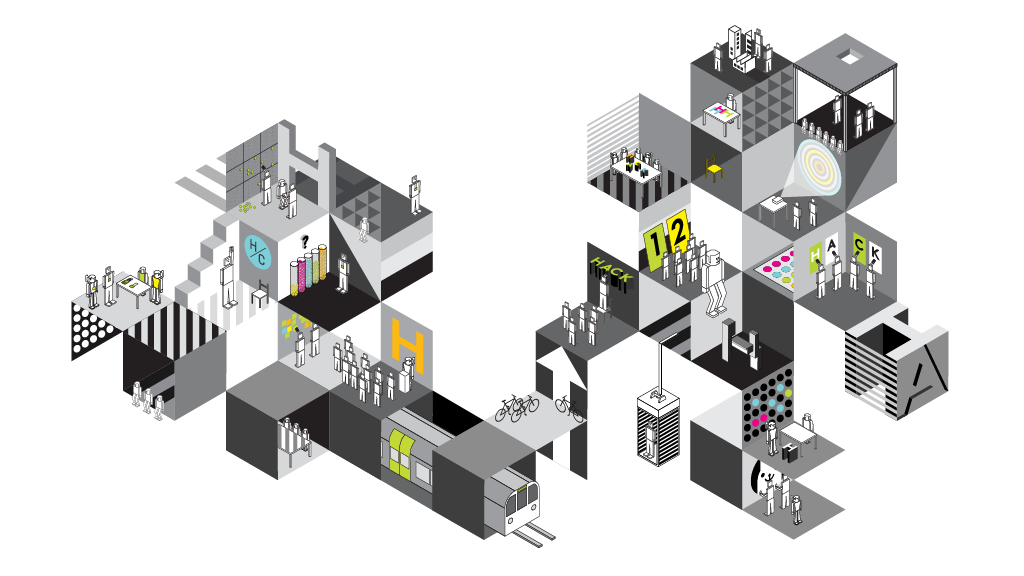Research Project Name
Hack the City
What We Did
Building on Gensler’s prior “Hackable Buildings” research, we developed speculative design proposals to improve our various local neighborhoods and cities via creative design intervention. To achieve this, we also developed an event-based exhibit format to gather innovative, cross-disciplinary feedback and hyper-local data directly from community members and stakeholders, which helped to refine our ideas and ensure relevance.
By conducting these design explorations and events in multiple cities, we were able to develop locale-specific design solutions, while exploring broader demands and trends in commercial development. Our goal is to use this process of engaging civic leaders and local stakeholders to improve and contextualize design solutions, and expand the scope and understanding.
The Context
Mobility and technology are changing the way we live and work. Our lifestyles are becoming more urban, driving a shift in expectations of the type, or even amount, of space we expect to have in which to live, work, and play. Rising prices in many cities are compounding the issue, shifting focus toward adaptive reuse of existing buildings and other underutilized infrastructure to make best use of the space and resources available. As a result, the challenge for architects, developers, and building owners in the future may increasingly be how to “hack” the buildings we already have, instead of how to build the next cool thing.
The Results
We gathered and documented our research to create a website (www.hackablecities.com) through which we, and the broader public, can engage with our research and ideas on a city-specific level, as well as begin to draw broader connections across geographies. This exercise highlighted some unexpected connections and similarity of issues between cities, and the digital platform has become a tool for dialogue.
The role of entrepreneurship in urban development, the influence of a thriving technology sector and workforce, and questions of placemaking and “stitching” together a disconnected urban fabric emerged as common themes across many of the cities explored. Questions around the right scale of development and the types of intervention needed were also frequent—in several projects, our teams chose not to focus on a specific building to hack, instead focusing on an entire block or district.
What This Means
Hack cities, not just buildings.
We must think beyond the interior and exterior design of individual buildings to focus on how they fit into the fabric of an urban neighborhood or district. Successful development serves this macro picture by integrating with nearby housing, transit, retail, dining, and educational institutions. Change may occur at the building scale, but impact should be felt well beyond.
Celebrate existing infrastructure.
We observe a growing interest in “authentic” existing buildings in many cities. A hackable approach can preserve an older building’s character while improving performance and usability for modern tenants.
Learn from other cities.
Opportunities and challenges must be identified at the local scale, but similar questions are often being tackled in other neighborhoods and cities as well. Integrate global knowledge and best practices into the design and development process.
Engage the public.
Issues of authenticity, context, and history are nuanced and cannot be approached in a top-down manner. Engaging public and civic stakeholders in the process of hacking our buildings and cities is an opportunity to integrate with the community and better uncover opportunities, insights, and successful strategies.
What’s Next?
Our current efforts are focused on further developing tools and processes to engage the public around the idea of hackable buildings and cities. Gensler has spent the past few years exploring this idea among our designers and clients, but we want to open it up to new and broader perspectives. We want feedback from end-users, developers, city leaders, community members, and other stakeholders on what they think a hacked building, space, or city can be. We want to motivate people and the community to activate vacant spaces, promote neighborhood development, and encourage creative entrepreneurship.
Learn More
Team
John Adams, Peter Weingarten, Tim Jacobson, Sarah Jacobson, Amanda Allen, Iva Andrejevic, Elaine Asal, Theresa Broderick, Dorothy Devin, Marie Fernandes, Ehren Gaag, Shawn Gehle, Brenden Jackson, Sarah Jones, Chris Melander, Vanessa Passini, Michael Pecirno, Alfredo Ruiz, Jonathan Sandoval, Peter Stubb, Natasha Valldejuly, Brandon Walt, Li Wen, Maria Wolf
Year Completed
2016
Comments or ideas for further questions we should investigate?
